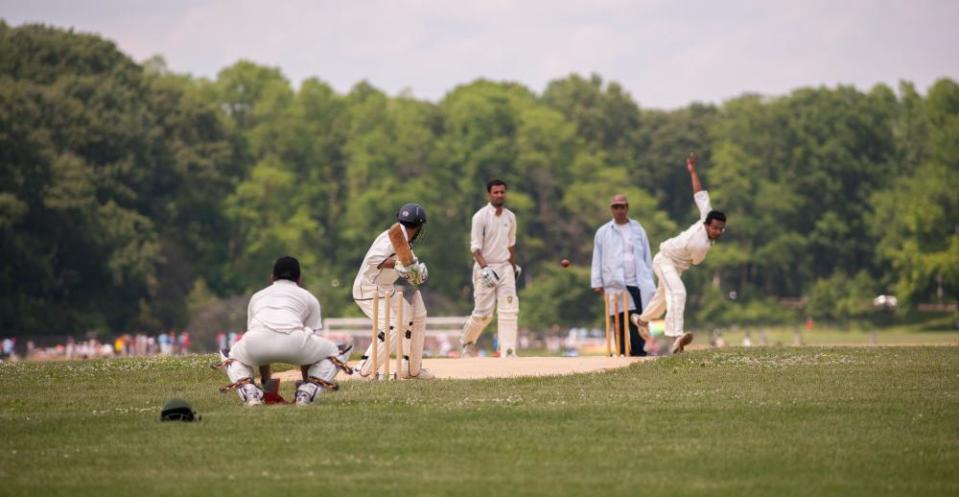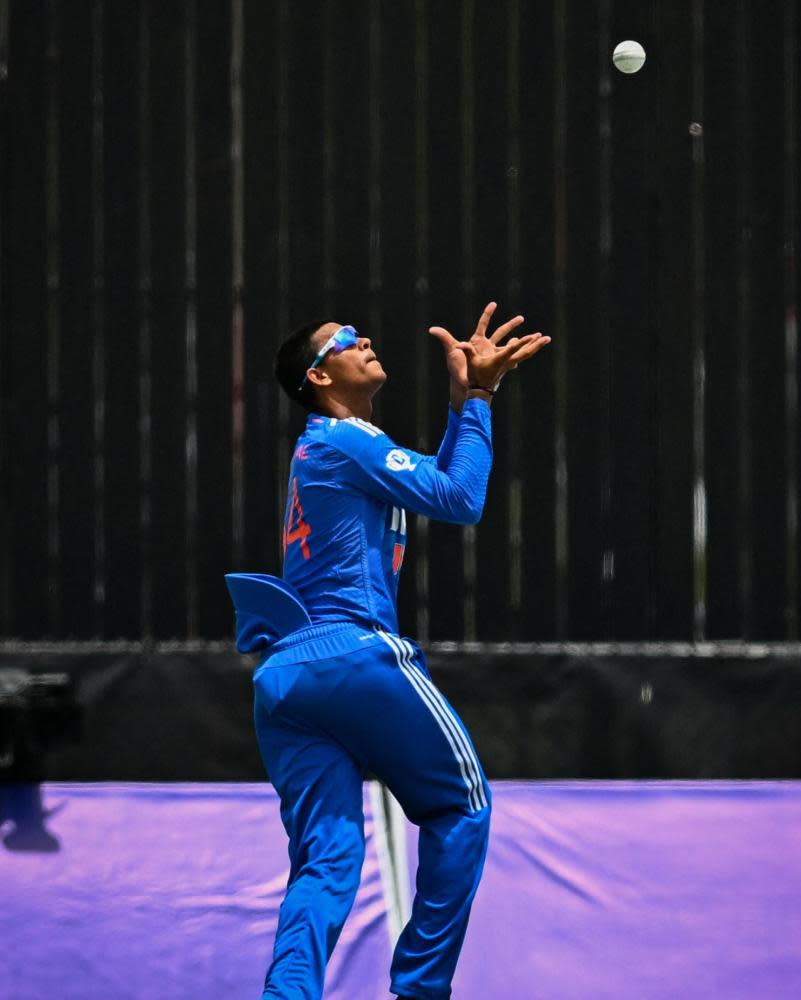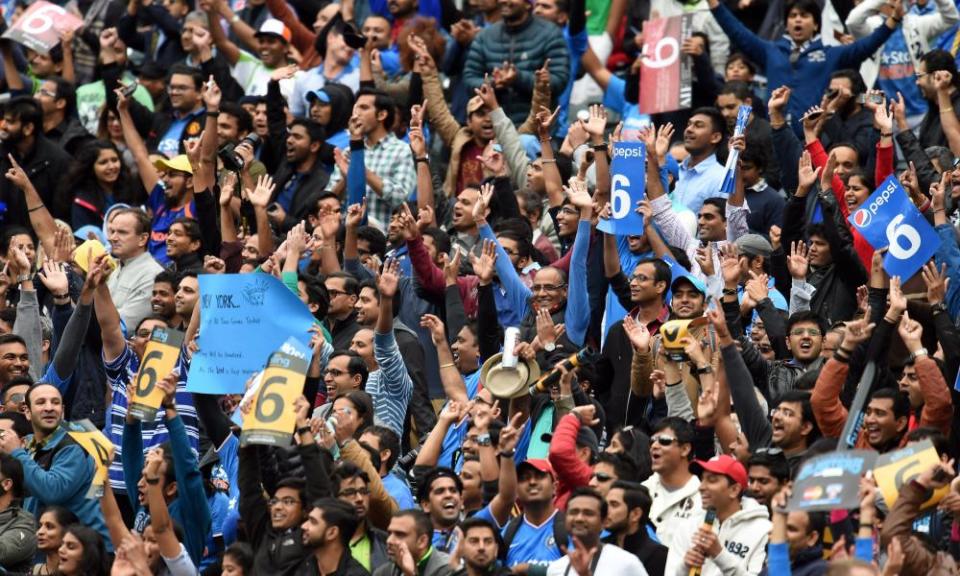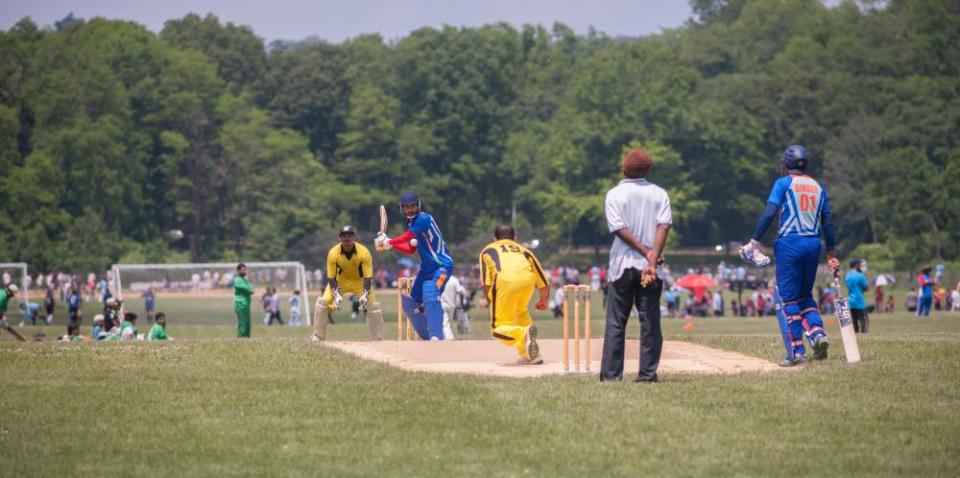‘They’re big, bad bullies’: New York’s bitter fight over a 34,000-seat cricket stadium
In Bangalore, Ajith Shetty’s life revolved around cricket. Playing since childhood, he’d captained his college squad, then company teams after starting a career in IT. But in suburban Long Island, where he moved for a job 17 years ago, mentioning the sport only drew blank stares. To cope with the isolation, he and a handful of other immigrants would play makeshift games in the dirt of baseball diamonds.
Then he discovered New York City’s sprawling Van Cortlandt Park. Amid the cacophony of the Bronx, it was a tree-ringed oasis, blessed with rare cricket fields. But the grounds were cramped and uneven, sending the ball bouncing awry. To create a proper surface, Shetty and other players had to roll out massive mats, which required six men to lug to and from a distant parking lot every game – a brutal hour-long round trip.
It was worth it just to keep cricket alive in an unforgiving new country. At the park, Shetty befriended other diehards, nearly all with Commonwealth roots, from longtime Caribbean New Yorkers to more recently arrived south Asians. “We’d all come together and play, and forget all our differences,” he says.
Today, the same park has pitted Shetty against his fellow cricketers in a clash with global stakes – over whether Van Cortlandt’s grounds should be loaned to world cricket authorities for a year to host one of the sport’s biggest events, the T20 World Cup.
The dispute has resurfaced long-simmering tensions within cricket’s international community, raising a billion-dollar question: is cricket truly ready to expand in the United States?
For much of the 20th century, cricket’s flame was kept flickering in the US thanks to generations of immigrants, predominantly from the Caribbean, playing on improvised fields in big cities. They treated cricket as a way to feel connected to home. “Guys used to take their children. You could come out there with a picnic basket,” says Milford Lewis, a Guyanese immigrant who for many years helmed the Van Cortlandt Park-based New York Cricket League. But “times have changed”, he says. “Now, people want to win at all costs.”
Related: T20 World Cup awards: the best and worst bits of the tournament | Simon Burnton
In the last two decades, professional cricket has been revolutionized by the popularity of the T20 format, which shortened cricket’s decorous multi-day contests into nail-biting, sub-three hour games. Leagues organized around this shorter form, in particular the Indian Premier League (IPL), now fetch multibillion-dollar broadcasting deals in south Asia. That energy has also been felt in New York, the American city with the most cricket fans, as promoters such as Shetty aim to build a cricket scene that can contend on the world stage.
There are now more recreational leagues playing at more parks across the city, the biggest of which remains Van Cortlandt, whose cricket fields were resurfaced and expanded 10 years ago. Shetty now serves as president of the 90-team Commonwealth Cricket League, which he says is the country’s largest. And for the first time in years there’s a credible professional presence. In July, the Mumbai Indians New York, a sister team to the IPL’s Mumbai Indians, defeated Seattle to win the first title in Major League Cricket – an ambitious American pro league that launched this year with more than $120m from investors with South Asian roots, such as Satya Nadella, the chief executive of Microsoft.
That glamor – along with at least $100,000 spent by lobbyists, records show – has apparently captivated New York’s mayor, Eric Adams, who frequently brags about bringing “swagger” back to the city, and is keenly interested in expanding its pro sports scene.

This year, representatives for the Dubai-based International Cricket Council (ICC), which governs professional cricket, approached Adams with an audacious proposal: to build a 34,000-seater pop-up cricket stadium on top of Van Cortlandt Park’s existing cricket fields in time for next June’s T20 World Cup. Adams was sold, and in July hosted an exuberant photo op with ICC members and the gleaming Cricket World Cup trophy. “It only makes sense to host the Men’s T20 World Cup 2024 in the melting pot that is New York City,” his spokesperson Brad Weekes tells the Guardian. “New York is ready to deliver a tournament that no other city will be able to offer.”
Shetty, who has been advising the ICC on the process, was also at the photo op on behalf of his recreational league, beaming in a tailored suit. “What’s happening is going to be historic,” he says.
What should have been a crowning moment has become a bitter standoff. Shortly after the proposal was announced, it was denounced by many of the city’s other recreational cricketers, who say the global cricket authorities never asked them if it would be OK to take their fields. And a coalition of neighborhood figures has formed to oppose the stadium, threatening a lawsuit over what they say would be a precedent-breaking misuse of public space.
The ICC is now struggling to save the plan, which it sees as a beachhead for its broader American ambitions. The United States is already confirmed as a co-host of the 2024 T20 World Cup, along with the West Indies, but that triumph would feel wasted without tapping into New York’s huge cricket fanbase. “Imagine,” says Shetty, “the biggest game, India v Pakistan, happening in New York.” These contests routinely sell out 100,000-seater venues in India, and if it were held in America’s global city, “the whole world would come here”.
Field of dreams
The glaring missing piece is the stadium. The oval of a cricket field is substantially larger than a baseball diamond, and the United States has just one ICC-approved cricket stadium, Florida’s 20,000-seat Central Broward Regional Park. Texas has a smaller stadium that can hold just 2,000 people. And New York, despite its huge cricket fanbase, has none at all.

Chubb Bedessee, a cricket equipment shop owner, is part of a coalition that has been trying to pitch a permanent cricket facility to New York City since the mid-2010s. “We did speak to former mayor Bill de Blasio about a stadium, but it wasn’t really on his agenda,” Bedessee says. “The problem with a cricket stadium is it’s not like you can use it six or seven months to bring in big revenue. In cricket, it’s really probably about 10 to 12 games for the entire year. ”
Hence the ICC’s proposal: a modular, temporary 34,000-seat stadium, built over the next few months directly on top of the recreational cricket fields, and then torn down following the T20 World Cup next June. At a projected $20m, the undertaking would be just a sliver of the cost of a permanent venue (a new 25,000-seat stadium for New York City’s Major League Soccer team will cost an estimated $780m and won’t be complete before 2027). The ICC has said that it would pay for the full cost of the construction and teardown.
That’s an easy decision, says Adams’ spokesman Weekes, who claims that the project “has the potential to generate $150m in potential economic activity and create thousands of new jobs”. As a bonus, Weekes points out, the ICC has pledged to upgrade the old cricket fields when it’s finished, in a “multimillion-dollar restoration of the cricket grounds for future generations of cricket lovers”.
The details are still lacking. The ICC declined to share its proposal or speak on the record with the Guardian, and Adams’ office declined to offer further information. Shetty says he doesn’t have access to proposal documents, but he says that it’s a “nice plan”.
“What ICC has said is they don’t want to take a single penny from taxpayers. It’ll help the local economy, it’ll help the cricket community, it will help everybody.”
‘Make some money, then move out’
In many other sports, the world’s biggest games coming to your neighborhood would be greeted with frenzied excitement. But the World Cup proposal has faced fierce opposition from some of New York’s most ardent cricket fans.
That includes Lewis, the Guyanese cricketer. “You’d be killing cricket in Van Cortlandt,” he says. Unlike Shetty’s Commonwealth League, Lewis’s much smaller New York Cricket League plays exclusively in that park – meaning its next season would probably be canceled due to the construction – and the players are angry that they weren’t consulted before the plan was unveiled. When Lewis and NYCL cricketers protested to the ICC, the authority told them that it wouldn’t consider alternatives. “They told us, ‘Van Cortlandt Park or nowhere else,’” Lewis says.
The ICC has tried to mollify them with an offer: it would not only repair, but upgrade all eight of Van Cortlandt Park’s recreational cricket fields after the tournament. But players are skeptical. If the ICC were actually committed to New York’s cricketers, it would have fought for a permanent stadium, says Lewis. A pop-up venue signals that it plans to just “make some money, and then move out and go”. Clarence Modeste, the longtime president of the Staten Island Cricket League, agrees: “ICC will put a stadium down, the matches will be played – and then their promises will be forgotten.”
Their suspicion reflects a long and rocky history between US cricketers and the global authorities. Lewis still resents the ICC for dismantling the United States of America Cricket Association (Usaca), the longtime national governing body where he served as a regional director in the 1990s. The ICC had blamed cricket’s slow growth in the US on Usaca’s mismanagement, but Lewis says the global body was unsupportive and impatient withAmerican efforts. “They’re a big, bad bully,” Lewis says.
There’s also an undercurrent of mistrust between West Indians who once held a more prominent role in the sport, like Lewis and Modeste – who is in his 90s – and the newer generations of south Asians who are largely in command of modern cricket. “The landscape has shifted dramatically,” says Lewis. “Cricket has become a very expensive sport, and [south Asians] have the resources.” That dynamic plays out in New York City, too, where the better-funded clubs are mostly or even exclusively south Asian, while Caribbeans have become more marginalized. “It doesn’t make us feel particularly happy,” Modeste says.

Shetty, who is from India, acknowledges that there’s tension. But cricket is “going to be dominated by Asians for the next 10 to 15 years”, he says, and others need to “accept the change”.
The real problem, he argues, is that those opposing the stadium are “old people” who are “selfish” and “not broad-minded”.
“They don’t have a vision about how to improve cricket in New York,” he says. “Their concern is: ‘Oh, we will not be able to play cricket for a few months.’ I said: ‘Boss, this is a once-in-a-lifetime event. And you can find another place to play.’”
New Yorkers say no
Even if the ICC can tune out the cries of Van Cortlandt Park cricketers, it must overcome an arguably tougher opponent: other New Yorkers, who so far have been nearly united in opposition.
At a July community board meeting for the Bronx district encompassing Van Cortlandt Park, speakers lined up to oppose the proposal. One neighborhood advocate, Deirdre Burke, said she’d enjoyed watching Van Cortlandt Park’s “uniquely respectful” amateur cricket games since the 1990s. But the stadium project would displace those local players and cause “enormous damage to our community”, she said. Chris Yarina, a volunteer with the non-profit Van Cortlandt Park Alliance, which manages the park, said the plan angered him. “It’s just all about the money.”
Jeffrey Dinowitz, a state assemblyman representing the district, believes that hosting the T20 World Cup at Van Cortlandt would violate New York’s public trust doctrine, which holds that parks may only be used for public enjoyment. Any other usage, known as “alienation”, would have to be approved by the state legislature, “and I ain’t sponsoring such legislation”, he says.

Adrian Benepe, New York City’s parks commissioner under the former mayor Michael Bloomberg, calls the stadium proposal “completely unrealistic and unprecedented”. Even one-night concerts in places like Central Park have to pay rental fees of as much as $2m, Benepe says, and those events are free to the public. The World Cup would be a perversion of that: a major sporting event taking over a public park for free, to charge people hundreds of dollars a ticket. “That would never have been allowed before,” he says.
The other red flag is that while the ICC has verbally pledged to repair the park afterward, it hasn’t offered to put up a restoration bond – typically a few million dollars – to ensure that it follows through. If the Dubai-based organization were to abscond after the Cup, “there could be no way to go after them legally to get the money back”, says the former official.
Benepe says the issue isn’t about cricket or cricketers – “I think the idea of hosting a major cricket tournament in New York is very attractive,” he says – but about park land, which is a public resource. “The thing I understood as parks commissioner was: you’re not the owner of the land to do with as you see fit,” he says. “You’re the manager of land that belongs to the people.” The stadium’s supporters, he says, “are not thinking about the long-term consequences of viewing park land as development space. It’s so precious, and New York City has so little of it.”
A race against time
With the clock ticking until the World Cup, the stadium’s odds of success are increasingly uncertain. If the ICC and Eric Adams try to proceed, community groups have signaled lawsuits arguing that the project requires the state legislature’s approval – and such a vote wouldn’t happen until January at the earliest.
That would leave the ICC just a few months to try to throw together a 34,000-seat stadium. “There would be litigation that would not be resolved for quite a while,” says Dinowitz, the local assemblyman. “I don’t see how it can be done.” Lewis believes that the Dubai-based body miscalculated in thinking that Adams’ approval alone would be enough to seal the deal. In New York, “you can’t just demand and then get,” he says.
In recent weeks, the ICC has gone quiet in its public statements about its plans. Shetty says that the body is “keeping everything tight-lipped” and he senses it could be “getting a little discouraged”. Still, he believes the organization is determined to make it work. The ICC has other locations in Texas, Florida, and North Carolina, he notes. But it wouldn’t be the same. “Everybody knows just the name itself. New York.”
If the World Cup stadium does somehow end up getting built, Modeste believes that even the most staunchly opposed cricketers will still attend. After all, this is cricket in America.
“What will happen is the ICC and the city put on their big boots and march over all opposition. The ICC will put the stadium down, the matches will be played. We’ll go and watch them.” Then, he predicts, the cricket executives will pack up, take their money, and leave the repairs to New York’s parks department, on the taxpayers’ dime. Players will struggle even more to find space. And then, after two or three years, he hopes, “we’ll go back to what we have now”.

 Yahoo Sport
Yahoo Sport 



































































